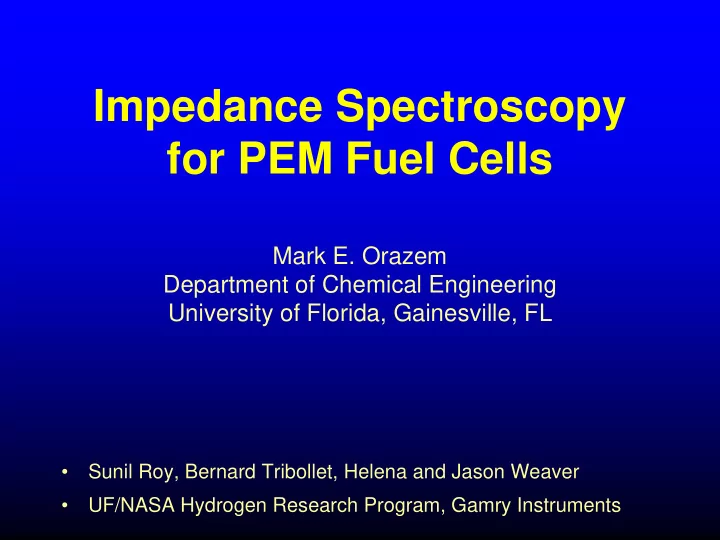

Impedance Spectroscopy for PEM Fuel Cells Mark E. Orazem Department of Chemical Engineering University of Florida, Gainesville, FL • Sunil Roy, Bernard Tribollet, Helena and Jason Weaver • UF/NASA Hydrogen Research Program, Gamry Instruments
Electrochemical Impedance Spectroscopy • Electrochemical technique – In-situ – transient – sensitive • Measurement in terms of macroscopic quantities – total current – averaged potential • Not a chemical spectroscopy
For many systems: EIS yields a physical description • Electrode-Electrolyte Interface – Electrical double layer – Diffusion layer – Kinetics • Electrochemical Reactions • Transport Processes
EIS has a BAD reputation for energy research • Technique over-sold • Questionable data – Nonstationary behavior – Instrument artifacts – nonlinearity • Too much information – technique is too sensitive • Interpretation in terms of electrical circuits – Models not unique – Models not connected directly to chemistry/physics • Nonuniform distributions of reactivity • Use of a CPE
Constant Phase Element (CPE) Semi-Circle R t Z R e -Z j 1 j C R 0 t Depressed Semi-Circle R t Z R e R e R e +R t Z r 1 j QR t CPE caused by distribution of time constants
The CPE is Controversial Liberation 20 March, 2006 Liberation 20 March, 2006 La Croix 17 March, 2006 La Croix 17 March, 2006
CPE: Contrat Première Embauche (First Employment Contract, 2006) Semi-Circle CPE: Constant Phase Element R t Z R e 1 j C R 0 t Depressed Semi-Circle R t Z R e 1 j QR t
PEM Fuel Cell R. Makharia, M. F. Mathias, and D. R. Baker, J. Electrochem. Soc. ,152 (2005) A970. S. K. Roy, M. E. Orazem, and B. Tribollet, J. Electrochem. Soc. , 154 (2007), B1378.
Error Analysis by Measurement Model
High-frequency artifacts extend to negative imaginary values
Impedance Data after Measurement Model Analysis S. K. Roy, M. E. Orazem, and B. Tribollet, J. Electrochem. Soc., 154 (2007), B1378. S. K. Roy and M. E. Orazem, J. Electrochem. Soc., 154 (2007), B883.
Process Model Development
Steps in Model Development 1.0 Steady-State Polarization Reaction 0.8 Current Curve Potential / V Mechanisms 0.6 Expressions 0.4 0.2 0.0 Apply 0.0 0.5 1.0 1.5 2.0 2.5 Sinusoidal Current / A Perturbation 0.10 0.05 2 Z j / cm Faradaic Impedance 0.00 0.00 0.05 0.10 0.15 0.20 0.25 Z r / cm 2 Double Layer Electrolyte Overall Capacitance Resistance Impedance
Proposed Reaction • Oxygen Reduction • Hydrogen Oxidation R. M. Darling and J. P. Meyers, J. Electrochem. Soc., 150 (2003) A1523.
Comparison to Data 0.10 2 Z j / cm 0.05 Experimental data Model 3 0.00 0.00 0.05 0.10 0.15 0.20 0.25 0.30 2 Z r / cm 1.2 1.0 Potential / V 0.8 0.6 Experimental data 0.4 Model 3 0.2 0.0 0.0 0.5 1.0 1.5 2.0 2.5 Current / A
Comparison to Data 0.10 0.05 2 Z j / cm Experimental data Model 3 0.00 0.00 0.05 0.10 0.15 0.20 2 Z r / cm 1.2 1.0 Potential / V 0.8 0.6 Experimental data 0.4 Model 3 0.2 0.0 0.0 0.5 1.0 1.5 2.0 2.5 Current / A
Comparison to Data 0.25 0.20 0.15 2 Z j / cm Experimental data 0.10 Model 3 0.05 0.00 -0.05 0.0 0.1 0.2 0.3 0.4 0.5 2 Z r / cm 1.2 1.0 Potential / V 0.8 0.6 Experimental data 0.4 Model 3 0.2 0.0 0.0 0.5 1.0 1.5 2.0 2.5 Current / A
Model development suggests supporting experiments • Formation of PtO • Reduction in electrochemically active area • Dissolved Pt in outflow S. K. Roy and M. E. Orazem, J. Electrochem. Soc., 156 (2009), B203. M. E. Orazem and B. Tribollet, Electrochim. Acta, 53 (2008), 7360.
Helena and Jason Weaver, University of Florida Evidence for PtO x
Electrochemical Impedance Spectroscopy • Electrochemical Technique – In-situ – Non-invasive – Sensitive to transport, kinetics, surfaces • Amenable to a Systematic Approach – Measurement models – Deterministic Models • Not a Stand-Alone Technique • Yields Insight – Reaction mechanisms – Degradation phenomena
Needs/Opportunities for EIS • Deterministic models – reactions – transport – nonuniform surfaces • Error analysis • Correlation to operating conditions – noise to flooding/drying – features to degradation mechanisms
Recommend
More recommend